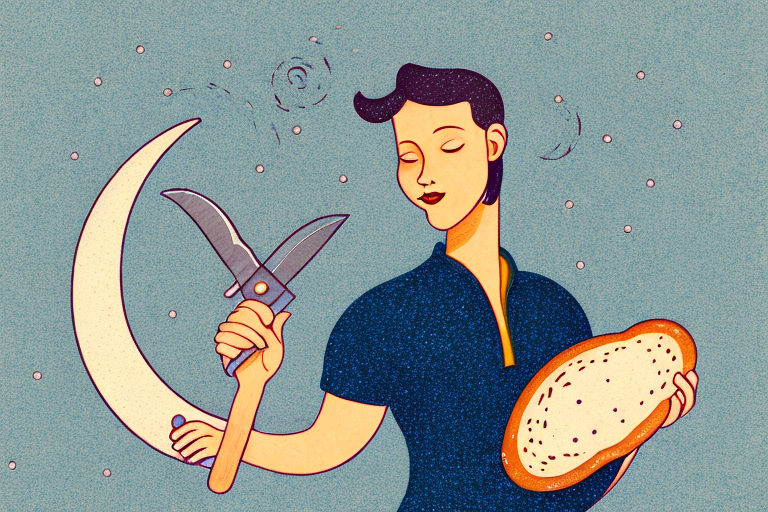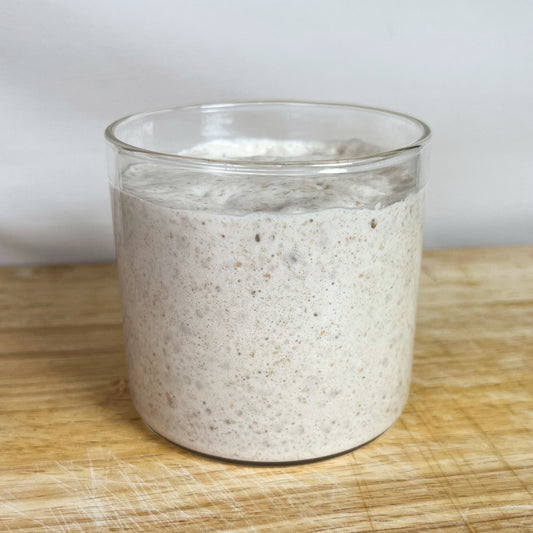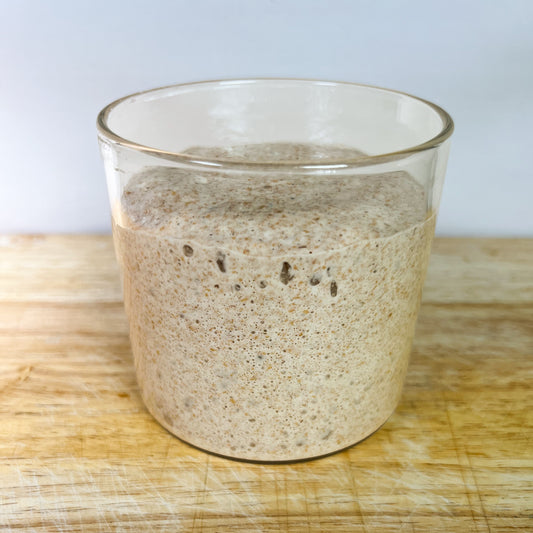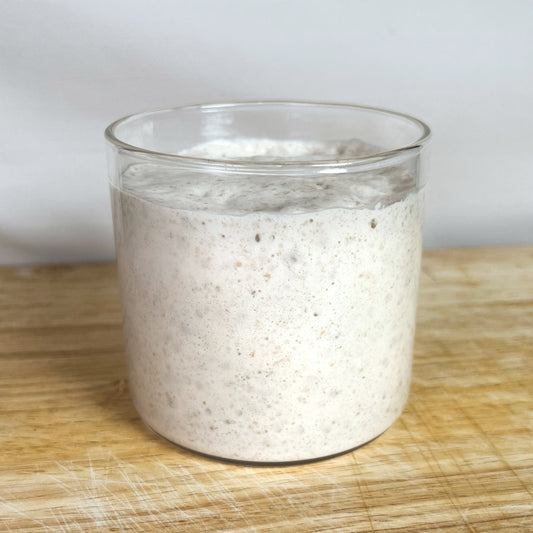Sourdough Bread Baking Essentials: Lames and Their Importance

If you love baking bread, then you know that there is something therapeutic about the process. The science behind fermentation and the precision of measurements that go into making a perfect loaf of bread is a craft that requires patience and time. Among the many tools that a bread baker needs, one essential is a lame. In this article, we will explore the importance of lames in the sourdough bread baking process.
Understanding Sourdough Bread Baking
Before we dive into the world of lames, let's first explore the process of sourdough bread baking. Sourdough bread is made without the use of commercial yeast. Instead, it relies on naturally occurring wild yeast and lactic acid bacteria to leaven the dough. These natural leavening agents create a complex flavor profile, making sourdough bread a sought-after bread variety.
The Science Behind Sourdough
The sourdough process involves capturing and growing a live culture of wild yeast and lactic acid bacteria called your sourdough starter. You can either make your own sourdough starter or buy sourdough starter to get started. The culture is then used to leaven the bread dough. The yeast and bacteria work together to ferment the dough, producing carbon dioxide gas, which causes the bread to rise. The lactic acid bacteria help to create the desirable tangy flavour of sourdough bread.
It's important to note that the process of capturing and growing a sourdough starter can take several days. This is because it takes time for the yeast and bacteria to colonise and become active. Once the starter is established, however, it can be used to make bread indefinitely, as long as it is regularly fed and maintained.
Key Ingredients for Sourdough Bread
There are three essential ingredients in sourdough bread: flour, water, and salt. The type of flour used can significantly impact the flavour and texture of the bread. Some bakers prefer to use a combination of different flours to achieve a unique flavour profile.
The hydration level of the dough is another critical factor that affects the final product. Typically, sourdough bread requires a higher hydration level than other bread types. This high-hydration dough results in a more open crumb and a chewy texture. Bakers often adjust the hydration level based on factors such as the type of flour used, the temperature and humidity of the environment, and personal preference.
The Role of Fermentation
The fermentation process is what gives sourdough bread its signature flavour. The longer the fermentation, the tangier the bread will be. The fermentation process can range from several hours to a couple of days, depending on the desired flavour profile.
During fermentation, the yeast and bacteria consume the sugars in the dough, producing carbon dioxide gas and organic acids. The organic acids contribute to the tangy flavour of the bread, while the carbon dioxide gas causes the bread to rise. The fermentation process also helps to break down complex carbohydrates in the flour, making the bread more digestible.
Some bakers prefer to do a cold fermentation, which involves fermenting the dough in the refrigerator for an extended period. This method allows for a slower fermentation, resulting in a more complex flavour profile and a chewier texture.
In conclusion, sourdough bread baking is a complex process that involves capturing and growing a live culture of wild yeast and lactic acid bacteria, using a high-hydration dough, and fermenting the dough for an extended period to achieve a tangy flavor and chewy texture. With patience and practice, anyone can master the art of sourdough bread baking.
The Art of Scoring Sourdough Bread
There's nothing quite like the smell of freshly baked sourdough bread wafting through the house. From the crispy crust to the soft, chewy interior, sourdough bread is a staple in many households. But did you know that scoring is an essential step in crafting the perfect loaf?
Why Scoring is Necessary
Scoring is the intentional, strategic cutting of the dough's surface to allow the bread to expand correctly during baking. Without scoring, the bread will not rise correctly and may even collapse in the oven.
When a sourdough bread dough is scored, it creates weak points in the dough's surface. As the bread bakes, the weak points expand, creating the bread's signature "ears" and allowing the bread to rise properly. Scoring also helps to release steam from the bread, which can prevent it from becoming too dense or soggy.
Techniques for Scoring Sourdough Bread
Scoring sourdough bread is an art form, and there are several techniques to achieve different patterns and shapes. The most common technique involves using a lame, a tool designed for precisely scoring the dough's surface.
A lame is a long, thin blade that is curved at the end, allowing bakers to make precise cuts in the dough. To use a lame, hold it at a 30-45 degree angle and make swift, confident cuts in the dough. It takes practice to master the technique, but it is well worth the effort.
Another popular scoring technique involves using a razor blade or a sharp serrated knife. However, these tools can be more difficult to control than a lame, making scoring more challenging.
Common Scoring Patterns and Their Effects
Scoring is not just a functional step in the baking process. It can also be a way to create visually appealing bread. There are several common scoring patterns, each with its unique effect on the resulting loaf.
- The single slash: This is the most basic scoring pattern, consisting of a single slash down the center of the dough. It is ideal for bread that is meant to be sliced for sandwiches.
- The cross pattern: This involves scoring two slashes that cross each other in the center of the dough, creating four quadrants. This pattern is ideal for a round loaf of bread and produces a beautiful, symmetrical pattern.
- The leaf pattern: This pattern involves creating curved slashes that resemble leaves. It is a great pattern for bread baked in a round or oval shape.
Other scoring patterns include the diamond pattern, which involves creating diagonal slashes in a diamond shape, and the spiral pattern, which involves creating a spiral shape on the surface of the dough.
When scoring sourdough bread, it's essential to consider the dough's hydration level and the desired shape of the loaf. A wetter dough may require a more shallow cut, while a drier dough may require a deeper cut.
Scoring is just one of the many steps involved in crafting the perfect loaf of sourdough bread. From mixing and kneading the dough to proofing and baking, every step requires attention to detail and a little bit of patience. But with practice and dedication, anyone can master the art of sourdough bread baking.
Introduction to Lames
Are you a passionate baker looking to take your bread-making skills to the next level? If so, you may want to consider investing in a lame. A lame is a kitchen tool that is specifically designed for scoring bread dough, and it can help you achieve beautifully shaped and textured loaves.
Read more here: Choosing the Right Bread Lame: A Buyer's Guide
What is a Lame?
A lame is a simple yet effective tool that consists of a handle and a razor blade. The blade is used to make precise cuts on the surface of bread dough, which allows the dough to expand during baking and creates the signature "ear" on the loaf.
While it may seem like any sharp blade could do the job, a lame is designed to make scoring easier and more precise. The blade is typically curved or angled in a way that allows you to make swift and accurate cuts without dragging or tearing the dough.
Types of Lames
There are two main types of lames: the straight lame and the curved lame. The straight lame is the most common type, and it is used for basic scoring patterns. The blade is typically straight and can be easily replaced when it becomes dull.
The curved lame, as the name suggests, has a curved blade that allows for more intricate scoring patterns. This type of lame is ideal for bakers who want to experiment with different shapes and designs on their loaves. Some curved lames even have interchangeable blades, which can be swapped out depending on the desired pattern.
How to Choose the Right Lame for You
When choosing a lame, there are a few factors to consider. First and foremost, think about the type of bread you will be baking. If you plan on making mostly basic loaves, a straight lame will likely suffice. However, if you intend to create more intricate patterns or work with sourdough or other types of artisanal bread, a curved lame may be a better option.
Another factor to consider is the blade itself. Look for a lame with a sharp, durable blade that can be easily replaced or sharpened when needed. The handle should also be comfortable to hold and easy to grip, as you'll be using the lame for extended periods of time.
Ultimately, the right lame for you will depend on your personal preferences and baking goals. With a little research and experimentation, you're sure to find the perfect tool to help you create beautiful, delicious bread.
Using a Lame Effectively
Preparing Your Lame for Scoring
To ensure that your lame is ready for scoring dough, you need to prepare it properly. First, make sure that the blade is securely fastened to the handle. Next, sharpen the blade using a sharpening stone or honing rod. A sharp blade makes it easier to score the dough's surface without tearing it.
Proper Scoring Techniques with a Lame
To use a lame effectively, hold the handle firmly, and use the blade to make swift, confident cuts on the dough's surface. Hold the lame at a slight angle to the dough and create a shallow cut to allow the bread to rise correctly.
Troubleshooting Common Scoring Issues
Scoring dough can be challenging, even for experienced bakers. It can be frustrating to see your bread not rise correctly or to have a jagged, uneven cut on the dough's surface. However, there are several common issues that bakers face when scoring dough, and there are ways to troubleshoot them.
One common issue is a dull blade. If your blade is not sharp enough, it may tear the dough's surface rather than creating a clean cut. Make sure to sharpen your blade before each use.
Another issue bakers face is scoring too deeply or too shallowly. Scoring too deeply can cause the bread to deflate, while scoring too shallow will not allow the bread to rise properly. It takes practice to achieve the right balance, so keep practicing, and don't get discouraged.
Conclusion
In conclusion, a lame is an essential tool for sourdough bread baking. Scoring the dough's surface allows the bread to rise properly, and the right lame can make scoring easier and more effective. With the right techniques and a bit of practice, anyone can master the art of scoring sourdough bread.




